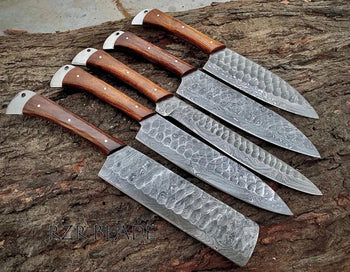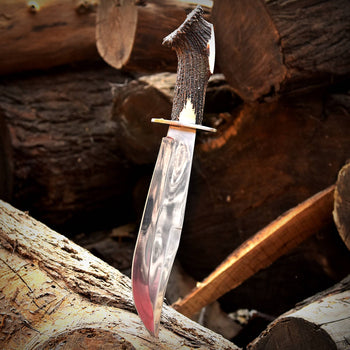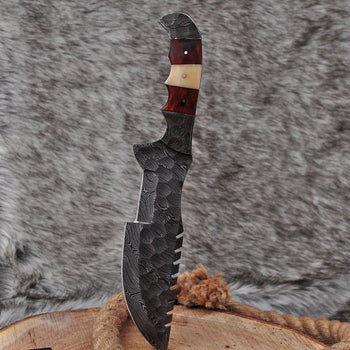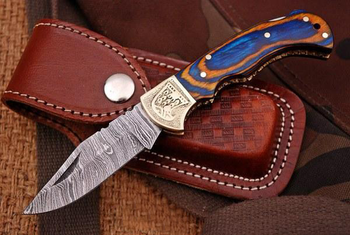Damascus steel knives have captivated knife enthusiasts, chefs, and collectors for centuries. With their signature wavy patterns and legendary history, these knives are often seen as the pinnacle of both beauty and performance.
But are Damascus steel knives just a visual masterpiece, or do they actually deliver when it comes to durability, sharpness, and functionality?
In this blog, we’ll uncover the truth behind Damascus steel, explore how it’s made, bust some myths, and help you decide if one of these elegant blades deserves a spot in your kitchen or gear bag.
What Is Damascus Steel?
Historically, Damascus steel referred to blades forged in the Near East from a type of crucible steel known as wootz, originating from India and Sri Lanka around 300–500 AD. These original blades were celebrated for their ability to hold a sharp edge and resist shattering—critical traits in ancient warfare.
The name "Damascus" may come from the city of Damascus in Syria, where these blades were traded, or from the Arabic word “damas,” meaning water, referring to the rippling surface patterns of the steel.
Unfortunately, the original technique was lost around the 18th century. Modern Damascus steel isn't the same as historical wootz steel, but today’s blades still mimic its appearance and aim to replicate its performance through pattern-welding techniques.
How Modern Damascus Steel Is Made
Today, Damascus steel is typically created by pattern welding, a process where layers of different steel types (often high-carbon and low-carbon steels) are forge-welded together, folded, and hammered repeatedly. The resulting billet is shaped into a blade, then acid-etched to reveal the distinct, flowing patterns.
This process doesn’t just create an attractive look—it can also result in a blade with a good balance of hardness, flexibility, and edge retention. However, the performance depends heavily on the quality of the steels used and the skill of the bladesmith.
Performance: Beauty Meets Function
A common misconception is that Damascus steel is purely decorative. In reality, a well-crafted Damascus steel knife can rival or even surpass many conventional blades in performance. Here’s how:
1. Edge Retention
High-quality Damascus knives often retain their edge longer than regular stainless steel knives. The combination of hard and soft steel layers can provide a fine edge that stays sharp over extended use.
2. Strength and Flexibility
The layering process can improve flexibility while maintaining strength. This means the knife is less likely to chip or snap under pressure.
3. Corrosion Resistance
Depending on the types of steel used in forging, modern Damascus knives can offer decent corrosion resistance. However, not all are rust-resistant, so maintenance is key.
4. Sharpness
Damascus knives are capable of achieving a razor-sharp edge. For chefs and outdoor enthusiasts alike, this precision is highly valued.
Common Myths About Damascus Steel
Let’s clear up a few popular myths:
“Damascus steel never dulls.”
This is false. All knives dull with use. The edge retention depends on steel quality and usage.
“All Damascus knives are high quality.”
Also untrue. Some manufacturers use laser etching or acid etching on plain steel to mimic the look without the performance. Always check the reputation of the maker and the materials used.
“Real Damascus steel is unbreakable.”
No blade is indestructible. While Damascus steel can be tough, improper heat treatment or cheap materials can make it brittle.
What to Look for When Buying a Damascus Knife
If you’re considering investing in a Damascus steel knife, keep these tips in mind:
Know the Steel Types: Look for blades made with reputable high-carbon steels like VG-10, 1095, or 15N20.
Examine the Pattern: Real Damascus has depth and flow to the pattern. If it looks flat or printed, it’s probably fake.
Ask About Heat Treatment: Proper heat treatment is crucial for performance. A well-treated blade will be harder and more durable.
Handle Materials: A quality Damascus kitchen knife should also come with a durable, ergonomic handle—wood, micarta, or G10 are good options.
Brand Reputation: Trustworthy brands or custom knife makers will be transparent about their forging process and materials.
Best Uses for Damascus Steel Knives
Damascus steel knives aren’t just for display. Depending on the blade style, they can be used for:
Kitchen tasks: Slicing, dicing, and precision cuts.
Hunting and outdoor activities: Skinning, field dressing, and survival needs.
Everyday carry (EDC): Folding Damascus knives are popular for daily utility and self-defense.
Damascus steel knives are more than just eye-catching blades. When made with quality materials and craftsmanship, they offer a unique blend of performance, edge retention, and visual appeal. While they may come at a premium price, the combination of artistry and utility makes them worth the investment for chefs, collectors, and outdoor adventurers alike.
So, whether you're looking for a reliable cutting tool or a standout piece for your collection, a Damascus steel knife could be exactly what you need—a beautiful blade that doesn’t compromise on performance. Buy now from AJ SANITY, one of the best knife store in USA.






![Alice Belts Are Back [Ultimate Guide] – Classic Military Gear for Today’s Adventurer](http://aj-sanity.com/cdn/shop/articles/DSC_6190.webp?v=1749141273&width=100)
![Top 5 Father’s Day Gifts for Dads Who Love Adventure [2025]](http://aj-sanity.com/cdn/shop/articles/DSC_2420_1fdbad4a-e3b1-42e3-bb1b-b78100cd538b.webp?v=1748364808&width=100)


![Why American Home Cooks Are Upgrading to Damascus Knives in 2025 [Top Reasons]](http://aj-sanity.com/cdn/shop/articles/DSC_5898_837e6509-a932-4060-9845-2f1397754cda.webp?crop=center&height=80&v=1745686270&width=80)